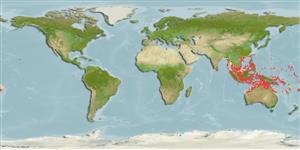分类 / Names
俗名 | 同种异名 | Catalog of Fishes(属, 种) | ITIS | CoL | WoRMS | Cloffa
Environment: milieu / climate zone / depth range / distribution range
生态学
海洋; 半咸淡水 礁区鱼类; 深度上下限 5 - 80 m (Ref. 37816). 熱帶; 25°N - 21°S
Indo-West Pacific: Thailand to Vanuatu, north to the Ryukyu Islands (Ref. 559) and southeast China, south to Australia.
印度-西太平洋: 泰國到萬那度,北至琉球群島 (參考文獻 559) 與中國東南部。
大小 / 重量 / 年龄
Maturity: Lm ? range ? - ? cm
Max length : 25.0 cm TL 雄鱼/尚未辨别雌雄; (Ref. 48635)
背棘 (总数): 15 - 17; 背的软条 (总数): 7-9; 臀棘 2; 臀鳍软条: 10 - 12. Body colors highly variable and best identified by the patterns on the fins (Ref. 48635). Lower 2 pectoral rays are entirely free and used as "walking" legs and the inner face of the fin is brightly colored (Ref. 37816).
体色高变异的而且在鳍上最易鉴定出来的特徵是图案.(参考文献 48635) 低的 2个胸鳍鳍条完全分离而且用作了 " 步行 " 腿,而且鳍的内面是色彩鲜艳的。 (参考文献 37816)
Found on open sandy or silty substrates of lagoon and seaward reefs. Often buries itself and easily overlooked. Uses pectoral fins to startle predators and shows color during courtship (Ref. 48635). Feeds on small fishes and crustaceans (Ref. 9710). The venom of this fish can be deadly to man. Its ability to camouflage itself by living half-buried presents a real danger. Solitary on sand and mud bottoms (Ref 90102).
栖息于泻湖与临海礁石的开放沙的或淤泥底部了。 时常埋藏它本身并且容易被看漏而不被发现。 使用胸鳍在求偶期期间惊吓掠食者而且展现颜色.(参考文献 48635) 吃小鱼与甲壳动物。 (参考文献 9710) 这一个鱼的毒液能是致人于死。 藉由半埋藏的生活习性伪装它本身的它能力呈现一种真正的危险。
Life cycle and mating behavior
成熟度 | 繁殖 | 产卵场 | 卵 | 孕卵数 | 仔鱼
印度-西太平洋: 泰國到萬那度,北至琉球群島 (參考文獻 559) 與中國東南部。
Myers, R.F., 1991. Micronesian reef fishes. Second Ed. Coral Graphics, Barrigada, Guam. 298 p. (Ref. 1602)
人类利用
水族馆: 商业性
更多信息
俗名同种异名新陈代谢捕食者生态毒物学繁殖成熟度产卵场产卵群集孕卵数卵卵的发育
参考文献养殖养殖信息品种遗传学Electrophoreses遗传率疾病加工NutrientsMass conversion
工具
特别资料
下载 XML
网络资源
Estimates based on models
Preferred temperature (Ref.
123201): 26.3 - 29, mean 28.2 °C (based on 1088 cells).
Phylogenetic diversity index (Ref.
82804): PD
50 = 0.5010 [Uniqueness, from 0.5 = low to 2.0 = high].
Bayesian length-weight: a=0.01862 (0.01022 - 0.03394), b=2.89 (2.73 - 3.05), in cm total length, based on LWR estimates for this species & (Sub)family-body (Ref.
93245).
营养阶层 (Ref.
69278): 4.0 ±0.66 se; based on food items.
回复力 (Ref.
120179): 中等的, 族群倍增时间最少 1.4 - 4.4年 (Preliminary K or Fecundity.).
Fishing Vulnerability (Ref.
59153): Low vulnerability (15 of 100).
Nutrients (Ref.
124155): Calcium = 55.4 [23.3, 140.2] mg/100g; Iron = 0.564 [0.265, 1.169] mg/100g; Protein = 18 [16, 20] %; Omega3 = 0.197 [0.081, 0.589] g/100g; Selenium = 31.7 [15.2, 76.9] μg/100g; VitaminA = 81.8 [20.5, 340.5] μg/100g; Zinc = 1.22 [0.79, 1.85] mg/100g (wet weight);
